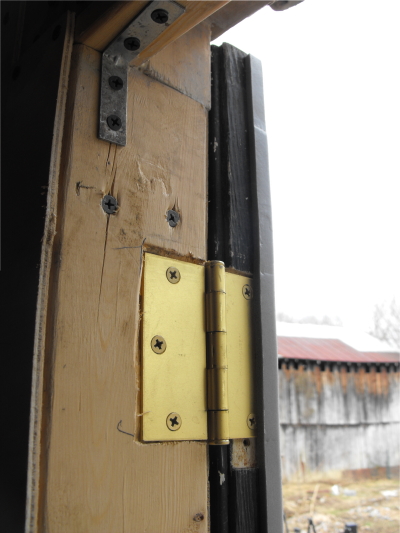
Home made door frame conclusion

The hinge area of the home
made door frame ended up with a small gap even though I chisled out
enough wood for the hinge to be flush with the frame.
A medium sized strip of
stick-on foam was enough to seal most of the space.
Making a door frame from
scratch wasn't as hard as I thought it might be, but I can already see
how much time a fabricated frame would save, especially if you're trying
to make it look perfect.
Want more in-depth information? Browse through our books.
Or explore more posts by date or by subject.
About us: Anna Hess and Mark Hamilton spent over a decade living self-sufficiently in the mountains of Virginia before moving north to start over from scratch in the foothills of Ohio. They've experimented with permaculture, no-till gardening, trailersteading, home-based microbusinesses and much more, writing about their adventures in both blogs and books.
Want to be notified when new comments are posted on this page? Click on the RSS button after you add a comment to subscribe to the comment feed, or simply check the box beside "email replies to me" while writing your comment.

I've yet to see a flexible material that doesn't harden/becomes brittle over the years. Most of those seals are some kind of elastomer. I suspect that the same properties that make those materials elastic also make them more susceptible to environmental damage, either from free radicals or UV radiation.
I guess silicone rubber is probably very good w.r.t. long-term flexibility, but it can be susceptible to mold.
Another issue is that a wooden outside doors need gaps all around for it to be able to dry properly, and to account for the wood shrinking and expanding. A door that fits too closely (especially at the end-grain of the wood) might stay wet longer and rot. So seals should be on the inside face of the door where they are least likely to get wet.
Personally, I prefer pulltruded fiberglass doors/windows and frames. They'll last for decades without much maintenance (no painting!) except for replacing the rubber wing seals occasionally. And since those seals are on the inside, they can last for at least 5-10 years.
I'm sorry to say but the problem appears to be that the jam (the part the door seals against) is missing so there will always be an air leak. With the door closed, make a 1x frame and (evenly) nail it to the door frame within about 1/8th inch of the door to allow installation of weather stripping (to seal it). Put a wiper on the bottom of the door and you're done.
Vester --- true, we could probably add in a jamb like we did on the other side. That might actually be what Daddy was suggesting too...
Roland --- I'll have to keep my eyes open for fiberglass doors at the thrift stores, which is where we got this one. Things do tend to turn up if I know what we're looking for!